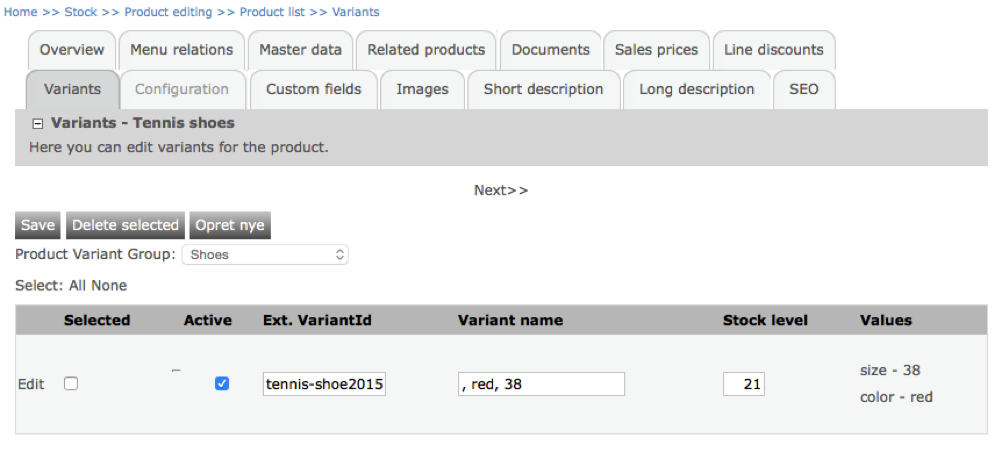Variant products are types of products that exist in different variants of different dimensions - for instance a product may exist in different variations of size and color. eSeller Cloud supports importing variant products via the FTP XML import. The purpose of this article is to clarity how to import variant products (and even variant product filters) using the FTP XML import. eSeller Cloud also supports importing variant products in CSV format using the built-in import wizard in the shop administration as well as manually creating variant products using the shop administration interface.
Variant dimensions
Variant dimensions are called ”Variant types” in the shop administration. Usual variant dimensions are color, size, or material and reflect a dimension in which a product can differ.
For instance you may have a variant product with the dimension “color”. This means that the same product exists in different variants of color – e.g. colors blue, red and green. The different colors are the values of the variant dimension. Some variant products have multiple variant dimensions, but usually no more than 2. For instance, a product may be available in different sizes (one dimension) or in different sizes and colors (two dimensions).
Below you see an example of how a variant dimension is specified in the XML import:
<variantDimension id="color">
<name>color</name>
<value id="blue">
<name>blue</name>
</value>
<value id="green">
<name>green</name>
</value>
<value id="red">
<name>red</name>
</value>
</variantDimension>
In the shop administration the variant dimension values are displayed like this:

Variant specifications
Variant dimensions are grouped in “variant specifications” (called “variant groups” in the shop administration). Variant specifications are used to define what variant dimensions can be specified for a variant product. For instance, you may have a variant specification called “Shoes” which holds the dimensions “size” and “color”. This means that if a product has the variant specification “Shoes”, the dimensions “size” and “color” must be specified.
Below you see an example of how a variant specification is specified in the XML import:
<variantSpecification id="shoes">
<name>Shoes</name>
<variantDimension>
<variantDimensionId>color</variantDimensionId>
</variantDimension>
<variantDimension>
<variantDimensionId>size</variantDimensionId>
</variantDimension>
</variantSpecification>
In the shop administration variant specifications are displayed like this:

See that the variant dimensions “size” and “color” are displayed under the “Attached variant types”.
Main variant products
The main variant product is not an actual physical product, but rather a representation of all variants of the product – that is for instance all colors and sizes of a product.
In the XML import the main variant product is specified as a normal product and what makes it a main variant product is that it has the <variantSpecificationId> element, which holds the ID of a variant specification:
<product id="tennis-shoe2015">
<productVatGroupId>VAT25</productVatGroupId>
<shopGroup>
<shopGroupId>1234</shopGroupId>
<enabled>1</enabled>
</shopGroup>
<variantSpecificationId>shoes</variantSpecificationId>
</product>
Actual variant products
The actual variant products (the ones that physically exist) are imported as “productVariants”. The main variant product is referenced in the <productId> element (which then determines what variant dimensions can be specified because of the variant specification set on the main variant product):
<productVariant id="tennis-shoe2015-red-38">
<productId> tennis-shoe2015</productId>
<variant>
<variantDimension>
<variantDimensionId>color</variantDimensionId>
<valueId>red</valueId>
</variantDimension>
<variantDimension>
<variantDimensionId>size</variantDimensionId>
<valueId>38</valueId>
</variantDimension>
</variant>
<inventoryCount>21</inventoryCount>
</productVariant>
In the shop administration, the variant product is found in the “Variants” tab of the main variant product.

Variant dimension sets - Filters
Variant dimensions may be used in the shop as filters – e.g. filtering a product list so that only products of a certain color are displayed. Filters can comprise of the values of many different variant dimensions and hence the filters are called “variant dimension sets”. This is useful as in many cases the ERP system (or whatever system is integrated) may create many different variant dimensions with the same types of values – e.g. some systems create specific variant dimensions per product. With variant dimension sets you are able to merge the dimension values of many different dimensions into one dimension set, which can then be used as a filter on the shop, containing all of the different values.
Note that eSeller Cloud is capable of merging values so that a value does not appear more than once. For instance – you may have many different dimensions with the value “red” but when creating a dimension set, the system will ensure that “red” only appears once in the dimension set.
Below you see an example of how to import a variant dimension set using the XML import. In this example the variant dimension set holds the values of the dimensions “color” and “colour”.
<variantDimensionSet id="colorFilter">
<name>Color filter</name>
<variantDimensionId>color</variantDimensionId>
<variantDimensionId>colour</variantDimensionId>
<language>
<languageId>ENG</languageId>
<name>Color filter</name>
</language>
</variantDimensionSet>
In the shop administration, the variant dimension set appears as a filter, ready for implementing to the product list pages for filtering products by color.

You can see the full import schema documentation here.